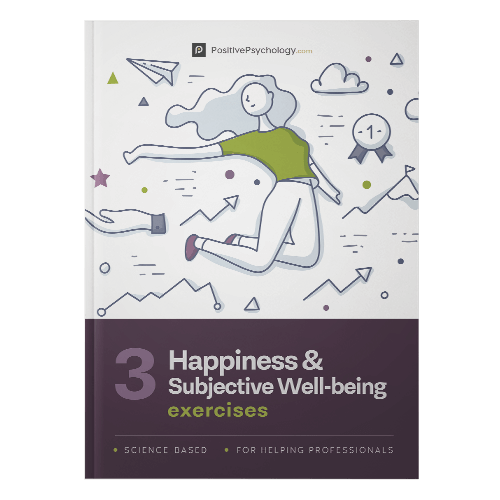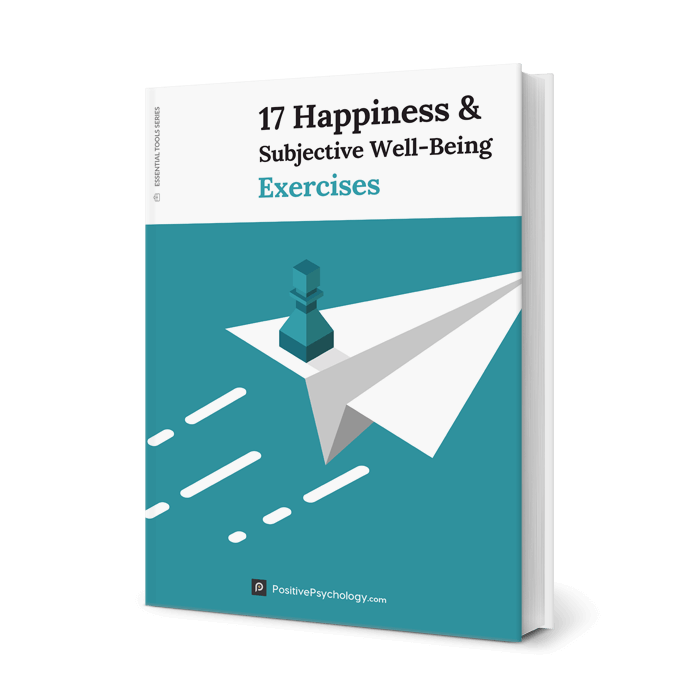What Is The Good Life & How To Attain It
 There has been a great deal written and said about how to live The Good Life.
There has been a great deal written and said about how to live The Good Life.
Yet with more than 8 billion people on this planet, there are probably just as many opinions about what the good life entails.
Positive psychology began as an inquiry into the good life to establish a science of human flourishing and improve our understanding of what makes life worth living (Lopez & Snyder, 2011).
We will begin this article by exploring definitions of the good life, before presenting a brief history of philosophical theories of the good life. Then we’ll introduce a few psychological theories of the good life and methods for assessing the quality of life, before discussing how you can apply these theories to live a more fulfilling life.
Before you continue, we thought you might like to download our three Happiness & Subjective Wellbeing Exercises for free. These detailed, science-based exercises will help you or your clients identify sources of authentic happiness and strategies to boost wellbeing.
This Article Contains:
What Is The Good Life?
The word ‘good’ has a very different meaning for very many people; however, there are some aspects of ‘the good life’ that most people can probably agree on such as:
- Material comfort
- Wellbeing
- Engagement in meaningful activities/work,
- Loving relationships (with partners, family, and friends)
- Belonging to a community.
Together, a sense of fulfillment in these and other life domains will lead most people to flourish and feel that life is worth living (Vanderweele, 2017).
However, the question ‘what is the good life?’ has been asked in many fields throughout history, beginning with philosophy. Let’s look at where it all began.
What Is The Good Life in Philosophy?
 This tricky question has preoccupied philosophers since the ancient Greeks, given it deals with the how and why of values and ethics, and how to live well.
This tricky question has preoccupied philosophers since the ancient Greeks, given it deals with the how and why of values and ethics, and how to live well.
According to Socrates
Interestingly enough, the ancient Greek philosopher Socrates never wrote anything down. His student Plato reported his speeches in published dialogues that demonstrate the Socratic method. Key to Socrates’ definition of the good life was that “the unexamined life is not worth living” (Ap 38a cited in West, 1979, p. 25).
Socrates argued that a person who lives a routine, mundane life of going to work and enjoying their leisure without reflecting on their values or life purpose had a life that wasn’t worth living.
However, he also argued that mere philosophical reflection was not sufficient for a good life. For Socrates, the good life requires self-mastery of our animal passions to ensure inner peace and the stability of the wider community. You can see a more detailed explanation of this in the video on Plato below.
According to Plato
Plato’s view of the good life was presented in The Republic (Plato, 380-375 BCE/2007) and supported the views of his teacher, Socrates. The Republic examines virtue and the role of philosophy, community, and the state in creating the conditions needed to live well.
In this dialogue, Socrates is asked why a person ought to be virtuous to live a good life, rather than merely appear to be virtuous by cultivating a good reputation. Socrates answers that the good life doesn’t refer to a person’s reputation but to the state of a person’s soul.
The role of philosophy is essential because philosophers are educated in using reason to subdue their animal passions. This creates noble individuals who contribute to a well-ordered and humane society. A person who is unable to regulate their behavior will be unstable and create suffering for themselves and others, leading to a disordered society.
Therefore, educated reason is crucial for cultivating virtuous conduct to minimize human suffering, both individually and socially. For Socrates and Plato, rational reflection on the consequences of our actions is key to establishing virtuous conduct and living the good life, both inwardly and outwardly.
For a fuller account check out the Wireless Philosophy video by Dr. Chris Surprenant below.
According to Aristotle
For Plato’s student Aristotle, the acquisition of both intellectual and character virtues created the highest good, which he identified with the Greek word eudaimonia, often translated as happiness (Aristotle, 350 BCE/2004).
Aristotle believed a person achieves eudaimonia when they possess all the virtues; however, acquiring them requires more than studying or training. External conditions are needed that are beyond the control of individuals, especially a form of state governance that permits people to live well.
It was Aristotle’s option that state legislators (part of Greek governance) should create laws that aim to improve individual character, which develops along a spectrum from vicious to virtuous. To cultivate virtue, reason is required to discern the difference between good and bad behavior.
For more on Aristotle’s version of the good life, click out the Wireless Philosophy video by Dr. Chris Surprenant below.
According to Kant
Immanuel Kant was a Prussian-born German philosopher active during the Enlightenment period of the late 18th century (Scruton, 2001). He is best known for his seminal contributions to ethics, moral philosophy, and metaphysics.
For Kant, a capacity for virtue is unique to human beings, because the ability to resist bodily desires requires the exercise of reason. Kant claims that human reason makes us worthy of happiness by helping us become virtuous (Kant, 1785/2012).
Kant’s argument describes the relationship between morality, reason, and freedom. One necessary condition of moral action is free choice.
An individual’s action is freely chosen if their reasoning determines the right course of action. Conduct is not freely chosen if it is driven by bodily desires like hunger, lust, or fear, or behavioral coercion that applies rewards and punishments to steer human actions.
For Kant, individuals should act only if they can justify their action as universally applicable, which he termed the categorical imperative (Kant, 1785/2012). He argued that all our behavioral choices can be tested against the categorical imperative to see if they are consistent with the demands of morality. If they fail, they should be discarded.
A virtuous person must exercise reason to identify which principles are consistent with the categorical imperative and act accordingly. However, Kant claimed that reason can only develop through education in a civilized society that has secured the external conditions required for an individual to become virtuous.
For example, an individual who lives in fear of punishment or death lacks the freedom required to live virtuously, therefore authoritarian societies can never produce virtuous individuals. Poverty also erodes an individual’s freedom as they will be preoccupied with securing the means of survival.
For a deeper examination of these ideas view the Wireless Philosophy video by Dr. Chris Surprenant below.
According to Dr. Seligman
Dr. Martin Seligman is widely regarded as one of the founding fathers of positive psychology. For Seligman, the good life entails using our character strengths to engage in activities we find intrinsically fulfilling, during work and play and in our relationships.
For Seligman, ‘the good life’ has three strands,
- Positive emotions
- Eudaimonia and flow
- Meaning.
Dr. Seligman’s work with Christopher Peterson (Peterson & Seligman, 2004) helped to develop the VIA system of signature strengths. When we invest our strengths in the activities of daily living, we can develop the virtues required to live ‘the good life’; a life characterized by positive emotional states, flow, and meaning.
Here is a video to learn more from Dr. Seligman about how cultivating your unique strengths is essential for living the good life.
Theories About The Good Life
Theories about what constitutes the good life and how to live it abound. This section will look at some of the most recent psychological theories about what contributes to the good life.
Set-Point Theory
Set-point theory argues that while people have fluctuating responses to significant life events like getting married, buying a new home, losing a loved one, or developing a chronic illness, we generally return to our inner ‘set point’ of subjective wellbeing (SWB) after a few years (Diener et al., 1999). This is largely inherited and tied in with personality type.
In terms of the Big Five personality traits, those predisposed to neuroticism will tend more toward pessimism and negative perceptions of events, while those who are more extroverted and open to experience will tend more toward optimism.
According to set-point theory, the efforts we make to achieve our life goals will have little lasting effect on our overall SWB given we each have our own ‘happiness set point’ (Lyubomirsky, 2007).
Furthermore, set point theory suggests that there’s little we can do for people who have been through a difficult time like losing their spouse or losing their job because they will eventually adapt and return to their previous set point.
This implies that helping professionals who believe they can improve people’s SWB in the longer term may be misguided. Or does it?
Other research provides evidence that achieving life goals can have a direct effect on a person’s overall contentment (Sheldon & Lyubomirsky, 2021). Specifically, pursuing non-competitive goals such as making a family, building friendships, helping others in our community, and engaging in social justice activities improve our sense of wellbeing.
On the other hand, pursuing competitive life goals like building a career and monetary wealth exclusively undermines SWB.
For set-point theory, the good life depends more on innate personality traits than education. For a surprising account of this, using a practical example, view the video below.
Life-Satisfaction Theory
Typically, life satisfaction refers to a global evaluation of what makes life worth living rather than focusing on success in one area of life like a career or intimate relationship, or the fleeting sense of pleasure we often call happiness (Suikkanen, 2011).
However, there tend to be two dominant theories of what causes life satisfaction: bottom-up theories and top-down theories.
Bottom-up theories propose that life satisfaction is a consequence of a rounded overall sense of success in highly valued life domains. Valued life domains differ from person to person. For a professional athlete, sporting achievement may be highly valued, while for a committed parent having a good partnership and stable family life will be super important (Suikkanen, 2011).
Of course, these are not mutually exclusive. For most people, multiple life domains matter equally. However, if we are satisfied with the areas that we value, a global sense of life satisfaction results (Suikkanen, 2011).
Top-down theories propose that our happiness set-point has a greater influence on life satisfaction than goal achievement. In other words, personality traits like optimism have a positive impact on a person’s satisfaction with life regardless of external circumstances, whereas neuroticism undermines contentment.
The debate continues, and life satisfaction is likely influenced by a combination of nature and nurture as with other areas of psychology (Suikkanen, 2011). You can read an extended discussion of the evidence in our related article on life satisfaction.
So, while life satisfaction is associated with living a good life, it’s not necessarily related to education, the exercise of reason, or the cultivation of virtues as proposed by the philosophers mentioned above. For example, a successful financial criminal may be highly satisfied with life but would be deemed a corrupt human being by such lofty philosophical standards.
Hedonic treadmill
Meanwhile, the concept of the hedonic treadmill proposes that no matter what happens, good or bad, a person will eventually return to their baseline emotional state. For example, if someone gets married, moves to a new home, is promoted, loses a job, or is seriously injured in an accident, eventually, they will default to their innate set point (Sheldon & Lyubomirsky, 2012).
This has also been termed hedonic adaptation theory (Diener et al., 2006). It means that no matter how hard we chase happiness or try to avoid suffering, ultimately, our innate tendencies toward pessimism or optimism return us to our baseline level, either dysphoria or contentment (Lyubomirsky et al., 2005).
If you tend to see the glass as half empty rather than half full, don’t be discouraged, because recent research by Sheldon and Lyubomirsky (2021) acknowledges that while we each have a happiness set point, we can also cultivate greater happiness. We’ve offered some tips in the ‘how to’ section below.
Assessing Your Quality of Life
 Defining a high quality of life will differ from individual to individual given the variety of personal values.
Defining a high quality of life will differ from individual to individual given the variety of personal values.
Nevertheless, assessing the quality of life has led to an abundance of international research using quality of life indicators (QoLs) in a variety of scales and questionnaires (Zheng et al., 2021).
Gill and Feinstein identified at least 150 QoL assessment instruments back in the mid-1990s (Gill & Feinstein, 1994). Since then, scales have been refined to measure the quality of life in relation to specific health conditions, life events, and demographic factors like age, ethnicity, and socioeconomic status (Zheng et al., 2021).
Our article Quality of Life Questionnaires and Assessments explains this in more detail and guides you on how to choose the best instrument for your clients.
Meanwhile, the Organisation for Economic Co-operation and Development (OECD) has developed the Better Life Index to measure how people from different demographics define a high quality of life. You can find out more in the brief video below.
How to Live The Good Life
How can each of us live the good life today given our array of differences? Below are five steps you can take to clarify what the good life means to you, and how you can apply your strengths to set goals that will lead to greater fulfillment.
1. Clarify your values
Clarifying what is important to you helps invest your life with meaning. Download our values clarification worksheet to get started.
2. Identify valued life domains
Investing in activities in valued life domains is intrinsically rewarding. Download our valued life domains worksheet to find out more.
3. Invest in your strengths
You can find out your character strengths by taking the free survey here. Playing to your strengths helps you overcome challenges and achieve your goals leading to greater life satisfaction. Read our article about how to apply strengths-based approaches to living well.
4. Set valued goals
Finally, we all benefit when we set goals and make practical plans to achieve them. Try our setting valued goals worksheet for guidance.
5. Ensure high-quality relationships
Healthy relationships with partners, family, friends, and colleagues are essential for living the good life and achieving your goals. To assess the quality of your relationships, take a look at our article on healthy relationships with free worksheets.
You can also look at our healthy boundaries article with more free resources. Healthy boundaries support you in living the good life in all life domains, while poor boundaries will leave you feeling unfulfilled.
In short, values-driven engaged activities and healthy, boundaried relationships provide the foundation for human flourishing and what is called the good life.
PositivePsychology.com Resources
We have an excellent selection of resources you might find useful for living the good life.
First, take a look at our Meaning & Valued Living Masterclass for positive psychology practitioners. This online masterclass follows a practical process of identifying values, investing in strengths and then applying them to living a more fulfilled life.
In addition, we have two related articles for you to enjoy while exploring the role of meaning in the good life:
- Realizing Your Meaning: 5 Ways to Live a Meaningful Life
- 15 Ways to Find Your Purpose of Life & Realize Your Meaning
Next, we have an article explaining the role of human flourishing in living the good life.
Finally, we have an article on how to apply values-driven goal-setting to living the good life.
We also have worksheets you may find useful aids to living the good life:
Our How Joined Up is Your Life? worksheet can help your client identify their interests and passions, assess how authentically they are living their life, and identify any values that remain unfulfilled.
This Writing Your Own Mission Statement worksheet can help clients capture what they stand for, their aims, and objectives. Having a personal mission statement can be useful to return to periodically to assess our alignment with our values and goals.
Finally, this How to Get What You Deserve in Life worksheet can help clients identify what they want as well as justify why they deserve a good life.
If you’re looking for more science-based ways to help others develop strategies to boost their wellbeing, this collection contains 17 validated happiness and wellbeing exercises. Use them to help others pursue authentic happiness and work toward a life filled with purpose and meaning.
A Take-Home Message
We all want to live the good life, whatever that means to us individually. The concept has preoccupied human beings for millennia.
If you currently struggle, which we all do at different times, we hope you’ll consider trying some of the science-based strategies suggested above to steer your way through.
All the evidence we have shared above shows that you can improve your life satisfaction and subjective wellbeing by living in line with your values. But you have to be clear about what’s important to you.
Values-based living invests your life with more meaning and purpose and is key to living the good life.
We hope you enjoyed reading this article. Don’t forget to download our three Happiness Exercises for free.
References
- Aristotle. (2004). Nicomachean ethics (Tredennick, H & Thomson, J.A.K., Trans.). Penguin. Original work published 350 BCE.
- Diener, E., Lucas, R. E., & Scollon, C. N. (2006). Beyond the hedonic treadmill: Revising the adaptation theory of well-being. American Psychologist, 61(4), 305–314.
- Diener, E., Suh, E. M., Lucas, R. E., & Smith, H. L. (1999). Subjective well-being: Three decades of progress. Psychological Bulletin, 125(2), 276–302.
- Gill, T. M., & Feinstein, A. R. (1994). A critical appraisal of the quality of quality-of-life measurements. Jama, 272(8), 619-626.
- Kant, I. (2012). Groundwork of the metaphysics of morals. Cambridge University Press. Original work published 1785.
- Lopez, S. L. & Snyder, C. R. (2011). The Oxford handbook of positive psychology. Oxford University Press.
- Lyubomirsky, S., Sheldon, K. M., & Schkade, D. (2005). Pursuing happiness: The architecture of sustainable change. Review of General Psychology, 9, 111–131.
- Lyubomirsky, S. (2007). The how of happiness: A scientific approach to getting the life you want. Penguin.
- Plato. (2007). The Republic (D. Lee, Trans.; 2nd ed.). Penguin. Original work published 380-375 BCE.
- Peterson, C., & Seligman, M. E. (2004). Character strengths and virtues: A handbook and classification (Vol. 1). Oxford University Press.
- Scruton, R. (2001). Kant: A very short introduction. Oxford.
- Sheldon, K. M., & Lyubomirsky, S. (2012). The challenge of staying happier: Testing the hedonic adaptation prevention model. Personality and Social Psychology Bulletin, 38(5), 670–680.
- Sheldon, K. M., & Lyubomirsky, S. (2021). Revisiting the sustainable happiness model and pie chart: Can happiness be successfully pursued? The Journal of Positive Psychology, 16(2), 145–154.
- Suikkanen, J. (2011). An improved whole life satisfaction theory of happiness. International Journal of Wellbeing, 1(1), 149-166
- Vanderweele, T. J. (2017). On the promotion of human flourishing. Proceedings of the National Academy of Sciences of the United States of America, 114(31), 8148–8156.
- West, T. G. (1979). Plato’s “Apology of Socrates”: an interpretation, with a new translation. Cornell University Press.
- Zheng, S., He, A., Yu, Y., Jiang, L., Liang, J. & Wang, P. (2021). Research trends and hotspots of health-related quality of life: a bibliometric analysis from 2000 to 2019. Health and Quality of Life Outcomes 19, 130.
Let us know your thoughts
Read other articles by their category
- Body & Brain (49)
- Coaching & Application (57)
- Compassion (26)
- Counseling (51)
- Emotional Intelligence (24)
- Gratitude (18)
- Grief & Bereavement (21)
- Happiness & SWB (40)
- Meaning & Values (26)
- Meditation (20)
- Mindfulness (45)
- Motivation & Goals (45)
- Optimism & Mindset (34)
- Positive CBT (28)
- Positive Communication (20)
- Positive Education (47)
- Positive Emotions (32)
- Positive Leadership (18)
- Positive Parenting (4)
- Positive Psychology (33)
- Positive Workplace (37)
- Productivity (16)
- Relationships (46)
- Resilience & Coping (36)
- Self Awareness (21)
- Self Esteem (38)
- Strengths & Virtues (31)
- Stress & Burnout Prevention (34)
- Theory & Books (46)
- Therapy Exercises (37)
- Types of Therapy (64)






What our readers think
For me a happy life is having the necessary things to have a good life in the physical aspect, economic aspect ,social aspect, achievement and also family, love and health . The luxuries are also good but they are extra things in life. The most important thing in life is love and peace.
This article made my day. Thank you for putting it together.
I lost approximately 14,000 dollars because of a bank fraud. This money is a product of my hardwork as a nurse and I have been saving it so I have a money when I travel back to be with partner. And the bank refused to refund my money. This incidence has made me feel devastated about life. It affected me emotionally and mentally. But I tried to contain this emotion for a few months and avoided to work and avoided my friends. But I am lucky that my parents, my sisters and especially my partner have been very supportive and understanding to me. They showed me the love and care I needed especially those tough times. Only a few days ago that I realised I should start to help myself and this is why I started to listen to a different talks and read articles that will help me to stay positive in life. Having this article read, it reminded me that I should be grateful that I am surrounded with great people. So thank you for sharing this article and making it accessible to everyone.